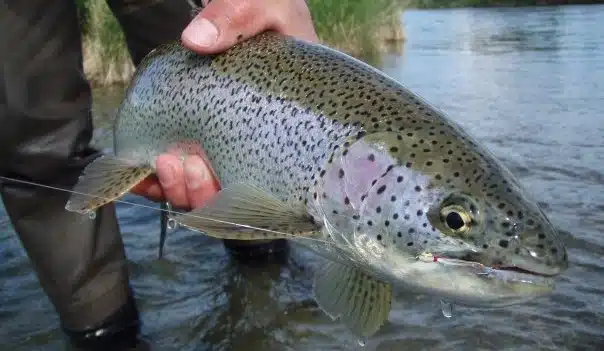Do you fly fish in a stream that has Kokanee or Sockeye salmon spawn in it? Are you going to Alaska in June? If you answered yes to either question then you should be prepared to fish fry patterns. Using these little feather and fur representations of tiny fish can be highly effective and frustrating. Knowing when to use these flies and how to present them can be essential for success when fishing waters where the trout are keying on these tasty little protein-rich morsels.
Sockeye and Kokanee alevins lurk near the gravel they hatched from for a couple of months.
Alevins don’t eat, instead, they are nourished off of a small

yolk sac that is attached under the belly, just behind the head until it is gone. Once the yolk sacs are consumed, the alevins are considered fry. These tiny little fry are now hardy enough to make the journey downstream to the lake that will be their home for the next few years. Anglers who can see the signs of migrating salmon fry have won half of the battle.
Exodus
Instincts are strong in the tiny little fish. If they weren’t, I am guessing their species would have disappeared a long time ago. When the little cusses get hungry and the water warms a bit they will start to migrate. Low light conditions also seem to spark the flood of these tiny salmonids probably because it helps hide them from predators (I have never asked one, so I am just assuming).
Fry will seek the fastest currents in the stream. This is good and bad for both predators and fly fishermen. The good is that the fastest currents shoot incredible amounts of traveling fry rapidly by waiting birds and fish allowing for enough to get by for the species to survive. The bad part is that the feeding lanes are so swift that trout have difficulty spotting and eating them and anglers have a hard time presenting the fly in the fast water. But first, you have to know when the migration has begun.

Unlike a dry fly hatch, the Sockeye fry rise to the surface and stop. Go figure. They do this because this is where the current is the fastest, but it does make them vulnerable to attack from above and below. When you see terns and gulls start diving to the water like yoyos, this is an indication that the fry are on the run. Often times if you are close enough you will see the tiny fish in the birds’ beaks before they swallow. Don’t bother to look into the water yourself because you will never see them. Tiny and well camouflaged, fry are harder to see than a size 28 midge.
The most obvious signal that fry are zipping down the river is the appearance of trout dorsal fins on the water’s surface. It is rare to see an open mouth when trout feed on fry. This is because the fry travel one to three inches under the top of the water column where they are afforded a little protection with the most water speed. That is why you will see dorsals and tails when the frenzy begins, not lips.
To Dry Fry or Not Dry Fry? That is the Question…
The surface is alive with big, beefy bows. Your hands are shaking as you tie on a fry pattern that looked so good that you wanted to eat it when you bought it. The water pulls at your legs as you wade into the swift water. After getting your footing, you spot a fish that is feeding at a frenzied pace. You start stripping line off your reel so fast you that you backlash your fly line and then you cast…….STOP!!
Ok, time to take a deep breath and think about stuff. First off is your bait, I mean fry fly. Most fry patterns that I have seen are tied so heavily that they are more of a small smolt pattern. Size 10, very sparsely tied patterns are the best. Ones with large red or yellow eyes work well at certain times, but they aren’t necessary. My favorite pattern is a deer hair, bullet head fry that a bunch of us guidely types developed while working at Kulik Lodge in Alaska. But there a few other commercial ties that would work will a little streamside trimming. I never, ever, had a client have a fry pattern in their box that worked until it was worked over a bit with the scissors.
The next step is to make sure that you have the proper tippet and it is prepared properly. In Alaska and in the lower 48 fly fishermen see rising trout and they think light leaders and tippet. Fortunately, you can get away with heavy stuff like 0x tippet and even 6lbs. Maxima. This is because the water is usually moving so fast where the fry migrate that the trout have little time to check out your tippet diameter. This also allows for the use of 6wt. or even 7wt. rod, which is nice in the heavy water. My preference is a 12’ 6wt. Spey rod, my old Sage works exceptionally well. I like the longer rods because of how they mend and the ease with which they cast at distance, which you will be doing because it is the time of year when the water is high.

Preparing the tippet is the key. Because the fry float just under the surface, you don’t want it on the surface. There are two ways to keep the fry fly (say that ten times fast!) where you want it in the water column where the trout are eating. The first is to dress your leader with some fly dressing within two to three inches of your fly. This lets the fly stay at the feeding depth of the trout for the entire drift.
My personal favorite is tying about three inches of fluorocarbon tippet to my mono-leader. The reason for this is that the fluorocarbon tippet sinks and tends to be a thinner diameter. Doing this gets the fly to feeding depth in the swift water much faster. Remember to dress the leader to the fluorocarbon tippet. Don’t worry about the trout being leery of the knot. They are usually too fixated on the fry jetting to their next home in the lake below.
The Hard Part
The fly is perfect and the leader is dressed. Now to fish. Fishing a fry pattern properly can be incredibly difficult. Water speed, coupled with the fact that fisherman doesn’t see the fish eat the fly are the two factors that stymie most anglers attempting to fish during the Sockeye and Kokanee fry migration. Now throw into the mix that you are probably standing waist deep in fast water. This has the makings of a long day.
Fish the fry like you would fish your favorite PMD pattern except that you will have to land your fly probably twice as far above the targeted fish then you would normally. Then mend like hell! Why? Because of the speed of the water where trout are normally feeding on fry and this allows the fly sink to their feeding depth faster. The great thing is that short, long or heavy casts don’t usually scare the fish off, even in the clearest water because of the rapid flow.
The cast and mend were perfect. You follow your fly line with your rod tip as it floats in the current. Suddenly, panic sets in when you realize that you can’t see your fly. Now you know the hard part. I have seen men and women alike, almost cry when they first attempt this technique.

When do you know that you have a fish? When the guide says; “Set!” for the first 10 or so fish. That is a joke-kind of. It is pretty much the same as fishing a tiny dry fly. Imagine a five-foot circle around where you think your fry pattern is or a ten-foot box from the end of your fly line and when you see fins set the hook. Eventually, instinct will take hold and your Jedi powers will almost let you know if you should set or not when you see a fish’s back close to where you this your fly is drifting.
Fry Fly Fishing
These simple techniques and flies have been used in Alaska, Canada and the lower 48 where there are Sockeye and Kokanee that have spawned. Some of the largest trout I have caught in Oregon and Idaho have been during the fry migrations in the spring. The same goes for Alaska too. The salmon fry migration can be one of the most memorable “hatches” that you can fish when you learn to do it properly.


